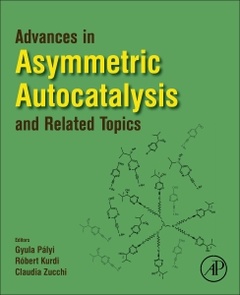Advances in Asymmetric Autocatalysis and Related Topics
Coordonnateurs : Palyi Gyula, Kurdi Robert, Zucchi Claudia

Advances in Asymmetric Autocatalysis and Related Topics provides various viewpoints on the important developments in asymmetric autocatalysis that have occurred in the past few years, also including brand new information in the field.
Asymmetric autocatalysis is a chemical reaction which leads from achiral starting materials to chiral products, and in which the product accelerates its own formation reaction (conventional catalysis) and promotes the prevalence of its own chiral configuration (asymmetric induction). The combination of these two effects in the same reaction was unprecedented before 1995 when it was first described by Kenso SOAI at the Tokyo University of Science.
Since then, several new combinations of this effect have been found, most intriguingly the possibility of absolute asymmetric synthesis, which is the spontaneous formation of the excess of one of the enantiomers of the product, a dream of organic chemists for more than a century.
The book contains expert-contributed chapters that describe the most exciting recent developments in the field of the Soai reaction and in related topics, ranging from mechanistic studies and theoretical research, to very practical problems in chiral syntheses and products.
2. Soai Autocatalyst As Conveyor Of Chirality Coupling Autocatalysis With Asymmetric Induction
3. Graph Theoretical And Statistical Analysis Of The Impact Of Soai Reaction On Natural Sciences
4. Kinetic And Structural Aspects Of Mirror-Image Symmetry Breaking In The Soai Reaction
5. Macromolecular Versus Micromolecular World
6. The Importance Of The Idea Of „Parachirality In Life Science
7. Graph Theoretical Tools In Two- And Three-Dimensional Chirality Problems
8. Synthesis Of Pyrimidine-Terminated Chiral Large Molecular Architectures With Functions Of Self-Replication And Self-Improvement By Asymmetric Autocatalysis
9. Model Equivalency In Interpreting The Stochastic Enantiomer Distribution In The Soai Reaction
10. On The Relative Measures Of The Degrees Of Chirality And General Asymmetry
11. Asymmetric Reduction Of Ketones To Chiral Platform Molecules
12. Searching For Spontaneous Mirror-Symmetry Breaking In Organoautocatalytic Reactions
13. Isotope Chirality In The Reagents And Intermediates Of The Soai Reaction
14. Chiral Polythiophenes
15. Abiotic Emergence Of Biological Homochirality
16. Catalytic Applications Of Supported Ionic Liquid Phases
17. Asymmetric Autocatalysis Initiated By Crystal Chirality Of Achiral Compounds
18. Structural Study Of Asymmetric Autocatalysis By X-Ray Crystallography
19. Amino Acids As Food Quality Factors In Parmigiano Reggiano Hard Cheese
Chemists working in synthesis and specifically on asymmetric catalysis and the Soai reaction in academia and industry; related scientists
Dr. Kurdi is an Associate Professor of Chemistry in the Institute of Environmental Technology of the University of Pannonia (Veszprém, Hungary); Head of Group in the Technology Transfer Centre of this University; and President of the "Lajos Bencze" Research and Development Foundation. He holds an MA (Diploma) in Chemistry (2000), PhD in Chemistry (2008), both from the University of Pannonia, and has published 22 articles in high-impact Journals, with over 200 citations.
Dr. Zucchi is Coordinator and Lecturer of the masters course in Handling of Chemical Substances (REACH & CLP) at the University of Modena and Reggio Emilia (Modena, Italy), under the patronage of the (Italian) Ministry of Health, as well as Tutor or Co-Tutor of Masters Theses at this University. She also served as Chair of the Scientific Committee of the 3rd International Symposium on the Soai Reaction and Related Topic (2015). She earned her MA (Diploma) in Chemistry (1989), PhD in Chemistry (1994) both at the University of Modena. Dr. Zucchi is the co-editor of 5 books (including 3 with Elsevier) and is author of 84 publications with over 700 citations.
- Features contributions from global experts, including several chapters from Kenso Soai and expert colleagues
- Focuses on recent developments in the field of asymmetric autocatalysis and newly reported findings
- Explores the Soai reaction, new developments, and the light it sheds on homochirality in certain biomolecules
Date de parution : 05-2017
Ouvrage de 408 p.
15x22.8 cm
Thèmes d’Advances in Asymmetric Autocatalysis and Related Topics :
Mots-clés :
3D Jordan property; Absolute asymmetric synthesis; Acid catalysis; Age-related diseases; Aging; Aldol reaction; Amplification of; Amplification of ee; Asymmetric amplification; Asymmetric autocatalysis; Asymmetric autotatalysis; Asymmetric catalytic amplification; Autocatalysis; Biochemically important molecules; Biological homochirality; Biomass conversion; Biotic chirality; By isotopes; Cataract; Cheese ripening; Chiral autocatalyst; Chiral crystal; Chiral crystal faces; Chiral isotopomers; Chirality; Chirality of cryptochiral compounds; Circularly polarized light; Community; D-amino acids; D-aspartyl (Asp) residues; D/l ratio of amino acids; DFT studies of; Degrees of; Detection of; Diastereoisotopomers; Enantioisotopomers; Enantiomeric excess; Enantiomeric excess distribution; Enantioselective autocatalysis; Enantioselective cross-catalysis; Enantioselective synthesis; Equivalent kinetic models; Free amino acids; Graph representations; Graph theory; HPLC analysis; Heterogeneous catalysts; Hydrogenation; Hypercyclic replicators; Imperfect symmetry; Intermediates of; Ionic liquids; Isoaspartate (β-aspartate); Isotope substitution; Jordan curve; Kinetic studies of; LC-MS/MS; Levulinic acid; Mannich reaction; Measure of; Mechanism of; Mirror-symmetry breaking; Modeling approach to; Multiasymmetric stereogenic centers; Multifunctional chiral molecules; NMR studies of; Optically active; Organocatalysis; Origin of life; Palladium catalysts; Parmigiano Reggiano cheese; Polythiophene; Prebiotic chirality; Primordial Darwinian selection; Protein; Reaction networks; Recycling; Self-improvement; Self-replication; Single chiral molecule; Soai reaction; Social network; Spin filter; Spontaneous; Statistical analysis; Statistics; Steady state treatment; Stochastic kinetics; Structure of; Symmetry breaking; Symmetry deficiency; Synthesis; Systems chemistry; X-ray crystallography; Zinc alkoxide; γ-valerolactone



